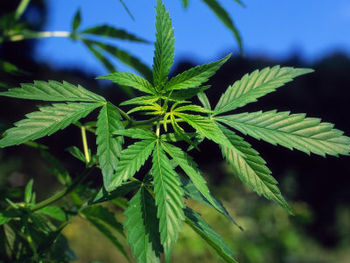Difference between revisions of "Cannabis Indica"
(→The benefits of Marijuana are) |
|||
| (21 intermediate revisions by 2 users not shown) | |||
| Line 1: | Line 1: | ||
| − | + | [[File:Indica.jpg|thumb|350px|left|Cannabis Indica]] | |
| − | See also : [[ | + | Cannabis indica is an annual plant in the Cannabaceae family. A putative species of the genus Cannabis, it is typically distinguished from [[Cannabis Sativa]].<br>See also : |
| − | + | * [[CBD Oil]] | |
| − | ==Special Precautions of | + | * [[Cannabinoids]] |
| − | + | ==Special Precautions of Cannabis Indica== | |
| − | + | ||
| − | + | ||
| − | + | ||
*Pregnancy and breast-feeding: Marijuana is UNSAFE when taken by mouth or smoked during pregnancy. Marijuana passes through the placenta and can slow the growth of the fetus. Marijuana use during pregnancy is also associated with childhood leukemia. Using marijuana, either by mouth or by inhalation is LIKELY UNSAFE during breast-feeding. The dronabinol (THC) in marijuana passes into breast milk. | *Pregnancy and breast-feeding: Marijuana is UNSAFE when taken by mouth or smoked during pregnancy. Marijuana passes through the placenta and can slow the growth of the fetus. Marijuana use during pregnancy is also associated with childhood leukemia. Using marijuana, either by mouth or by inhalation is LIKELY UNSAFE during breast-feeding. The dronabinol (THC) in marijuana passes into breast milk. | ||
| − | * | + | *Side effects of marijuana use include dry mouth, nausea, vomiting, headache, red eyes, heart and blood pressure problems, numbness and sexual problems. |
| − | * | + | *Other side effects include weakened immune system, hallucinations, impaired mental ability, panic reaction, depression and dizziness. |
| − | * | + | *Long term smoking of marijuana will likely cause unfavorable side effects to the lungs such as the development of emphysema. |
| − | + | ||
| − | + | ||
| − | + | ||
| − | + | ||
| − | + | ||
| − | + | ||
| − | + | ||
| − | == | + | ==Benefits and uses of Cannabis Indica are== |
| − | + | [[File:Cannabis.jpg|thumb|450px|left|Cannabis]] | |
| − | + | Cannabis indica has a higher ratio of CBD:THC compared to [[Cannabis Sativa]]. Cannabis strains with relatively high CBD:THC ratios are less likely to induce anxiety than vice versa. This may be due to CBD's antagonistic effects at the cannabinoid receptors, compared to THC's partial agonist effect. CBD is also a 5-HT1A receptor (serotonin) agonist, which may also contribute to an anxiolytic-content effect. This likely means the high concentrations of CBD found in Cannabis indica mitigate the anxiogenic effect of THC significantly. The effects of sativa are well known for its cerebral high, hence used daytime as medical cannabis, while indica is well known for its sedative effects and preferred night time as medical cannabis. Indica plants are normally shorter and stockier plants than sativas. They have wide, deeply serrated leaves and a compact and dense flower cluster. The effects of indicas are predominantly physical and sedative. Due to the relaxing nature of indicas, they are best used for non-active times of the day and before bed. | |
| − | + | ||
| − | + | ||
| − | + | ||
| − | + | ||
| − | + | ||
| − | + | ||
| − | + | ||
[[Category:Treatments]] | [[Category:Treatments]] | ||
[[Category:herbal medicine]] | [[Category:herbal medicine]] | ||
Latest revision as of 01:57, 13 August 2016
Cannabis indica is an annual plant in the Cannabaceae family. A putative species of the genus Cannabis, it is typically distinguished from Cannabis Sativa.
See also :
Special Precautions of Cannabis Indica
- Pregnancy and breast-feeding: Marijuana is UNSAFE when taken by mouth or smoked during pregnancy. Marijuana passes through the placenta and can slow the growth of the fetus. Marijuana use during pregnancy is also associated with childhood leukemia. Using marijuana, either by mouth or by inhalation is LIKELY UNSAFE during breast-feeding. The dronabinol (THC) in marijuana passes into breast milk.
- Side effects of marijuana use include dry mouth, nausea, vomiting, headache, red eyes, heart and blood pressure problems, numbness and sexual problems.
- Other side effects include weakened immune system, hallucinations, impaired mental ability, panic reaction, depression and dizziness.
- Long term smoking of marijuana will likely cause unfavorable side effects to the lungs such as the development of emphysema.
Benefits and uses of Cannabis Indica are
Cannabis indica has a higher ratio of CBD:THC compared to Cannabis Sativa. Cannabis strains with relatively high CBD:THC ratios are less likely to induce anxiety than vice versa. This may be due to CBD's antagonistic effects at the cannabinoid receptors, compared to THC's partial agonist effect. CBD is also a 5-HT1A receptor (serotonin) agonist, which may also contribute to an anxiolytic-content effect. This likely means the high concentrations of CBD found in Cannabis indica mitigate the anxiogenic effect of THC significantly. The effects of sativa are well known for its cerebral high, hence used daytime as medical cannabis, while indica is well known for its sedative effects and preferred night time as medical cannabis. Indica plants are normally shorter and stockier plants than sativas. They have wide, deeply serrated leaves and a compact and dense flower cluster. The effects of indicas are predominantly physical and sedative. Due to the relaxing nature of indicas, they are best used for non-active times of the day and before bed.

